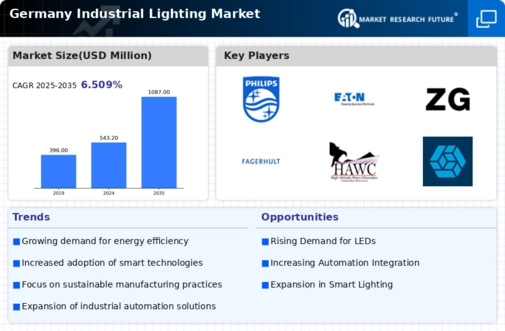Growing Demand for Energy Efficiency
The industrial lighting market in Germany is experiencing a notable shift towards energy-efficient solutions. This trend is driven by increasing operational costs and the need for sustainability. Companies are seeking to reduce energy consumption, which has led to a surge in the adoption of energy-efficient lighting technologies. According to recent data, energy-efficient lighting can reduce energy usage by up to 70%, making it a compelling choice for industrial applications. Furthermore, the German government has implemented various incentives to promote energy efficiency, which is likely to further stimulate growth in the industrial lighting market. As industries strive to meet stringent environmental regulations, the demand for energy-efficient lighting solutions is expected to continue rising, thereby shaping the future landscape of the industrial lighting market.
Focus on Workplace Safety and Productivity
In the industrial lighting market, there is a growing emphasis on enhancing workplace safety and productivity. Adequate lighting is essential for ensuring a safe working environment, particularly in manufacturing and warehousing sectors. Poor lighting can lead to accidents and decreased productivity, prompting companies to invest in high-quality lighting solutions. Research indicates that well-lit workplaces can improve employee productivity by up to 15%. As German industries prioritize safety and efficiency, the demand for effective lighting solutions is expected to rise. This focus on workplace safety not only aligns with regulatory requirements but also contributes to a more engaged and productive workforce, thereby driving growth in the industrial lighting market.
Regulatory Framework and Compliance Requirements
The regulatory framework surrounding energy efficiency and environmental standards is a significant driver in the industrial lighting market in Germany. The government has established stringent regulations aimed at reducing energy consumption and promoting sustainable practices. Compliance with these regulations is essential for companies operating in the industrial sector. As a result, there is a heightened demand for lighting solutions that meet these regulatory standards. The industrial lighting market is likely to see increased growth as companies invest in compliant lighting technologies. Furthermore, the evolving regulatory landscape may encourage innovation and the development of new products that align with these requirements, thereby shaping the future of the industrial lighting market.
Technological Advancements in Lighting Solutions
Technological innovation plays a crucial role in the evolution of the industrial lighting market in Germany. The introduction of advanced lighting technologies, such as smart lighting systems and IoT integration, is transforming how industries approach lighting. These innovations not only enhance energy efficiency but also improve operational efficiency and safety. For instance, smart lighting systems can adjust brightness based on occupancy, leading to further energy savings. The market for smart lighting was projected to grow significantly, with estimates suggesting a compound annual growth rate (CAGR) of over 20% in the coming years. As industries increasingly recognize the benefits of these technologies, the industrial lighting market is likely to witness substantial growth driven by technological advancements.
Sustainability Initiatives and Corporate Responsibility
Sustainability initiatives are becoming increasingly important in the industrial lighting market in Germany. Companies are under pressure to adopt environmentally friendly practices, and lighting is a critical area for improvement. The shift towards sustainable lighting solutions, such as LED technology, aligns with corporate responsibility goals and helps reduce carbon footprints. Many German companies are setting ambitious sustainability targets, which often include transitioning to energy-efficient lighting systems. This trend is supported by consumer preferences for environmentally responsible products, further driving the demand for sustainable lighting solutions. As businesses strive to enhance their sustainability profiles, the industrial lighting market is likely to benefit from this growing commitment to corporate responsibility.























Leave a Comment